Robotic farming on a Kiwi dairy farm
Farm Trader visited a dairy farm at Bunnythorpe in the Manawatu region that’s embracing new technology. In fact, it uses robots to milk its cows.
When Greg Gemmell and his wife Amy decided to install a robotic milking system 18 months ago, it was a bold decision, but the couple, who are herd-owning sharemilkers on Amy’s parents, Brian and Margaret Schnell’s 82-hectare farm, have no regrets.

They milk up to 230 Friesian cows – currently milking 181 – through three Lely Astronaut A4 robots with the robots processing a maximum of 70 to 80 cows each.
The family can already see the benefits, which include a lightened workload and boosted production – 20% higher from 40 fewer cows.
Greg is also enjoying the fact that he no longer starts his day at 5am; it’s now more like 7am. The robotic system revolves around the concept that cows have the freedom to choose when to eat, drink, rest, or be milked. This is known as free range, pasture-based, voluntary milking.
Why choose robotic milking?
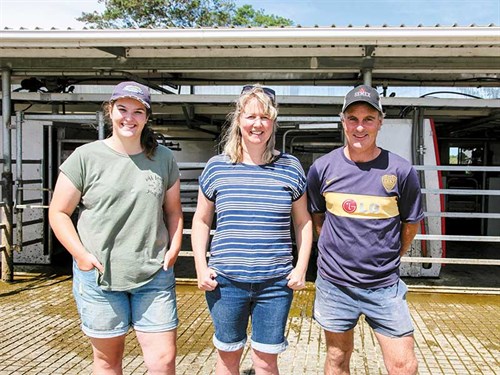
There were a number of reasons for moving away from a conventional herringbone shed. "We’re a relatively small farm and while it fully supports two families, getting in an extra full-time worker was becoming less viable. Besides, our herringbone shed was ready for a major upgrade. There were a whole bunch of things we needed to replace," Amy says.
"Greg was also feeling the effect of standing on concrete twice a day for 25 years and didn’t fancy a further 20 years down in the pit."
When Amy’s father visited an organic robotic farm in Auckland, he was impressed with it and suggested they should do the same.
"At first I thought he was joking but then I realised he was keen to go ahead. Once we made the decision, it happened within about five months," Amy says.
She says it was relatively easy to train the herd into the new set up. Eighteen months down the track, they are working smarter rather than harder, the health of the herd has improved, and they are visibly more contented.
Amy and Greg, who have three sons – Flynn (10), and twins Hadley and Ronan (7), find more family time and so are happier too. Greg adds, "I am still very connected to my herd. In fact, with this way of working, it’s more so. All I used to see was their bums and udders; now I see their faces and I am in the paddock with them a lot too."
Robotic milking system
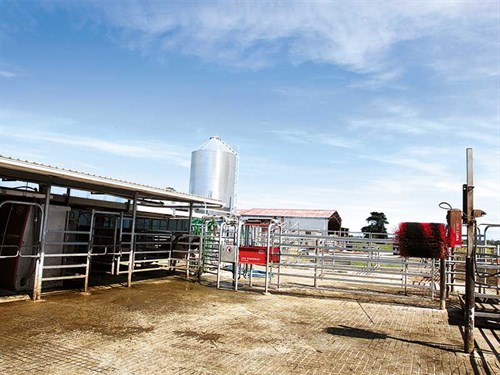
The Lely Astronaut A4 robotic milking system has been designed to suit the Schnell and Gemmell farm with the health and wellbeing of their animals in mind. Gates have been placed so cows have easy access to the robot and are not forced into the cow box.
A feed stall in the box draws them in, the brushes wash their teats before teat cups are automatically engaged. Once milking is complete, the cow exits and voluntarily goes to the Lely Luna brush for a luxurious pampering, before exiting to the race, and then the paddock.
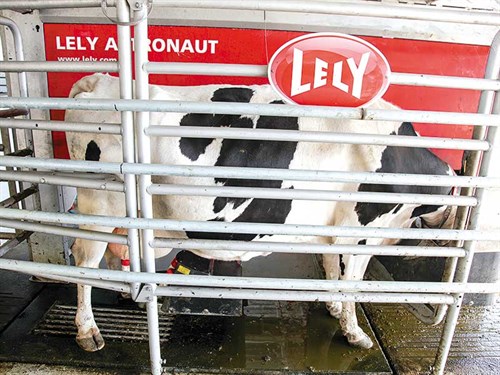
"Cows come in of their own free will; we rarely bring them in. Some milk up to three times a day – they have that option, particularly in early lactation – and others do two.
We have cows coming in the middle of the night but others will stay in the paddock and go to sleep. It gets busy around the time the gates change to a new paddock, and the cows learn this quite quickly. Our cows are healthy and are the heaviest they’ve ever been," Amy says.
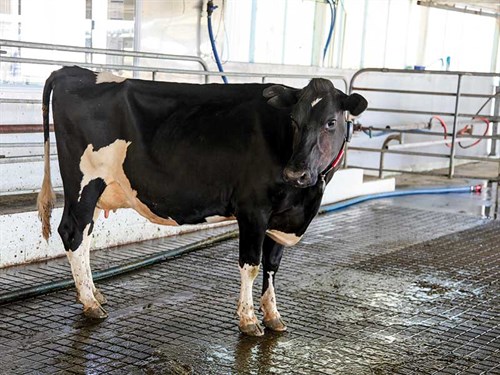
"We have no lame ones and that’s amazing because last winter was very wet. It’s rare to have sick cows because this system alerts us very quickly to any problem," Greg says.
Greg is also the herd’s AB technician, and the data from each cow’s responder (a collar on their neck) tells him the optimum time for conception, via both the computer and phone, which is set to receive an alert similar to a text message.
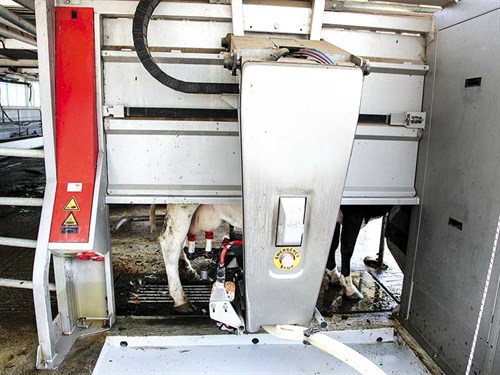
This messaging service applies to calving as well. Calving dates are entered into the computer and Greg receives updates once a cow starts showing signs (getting niggly and going off her food) of giving birth.
Feed-driven grazing
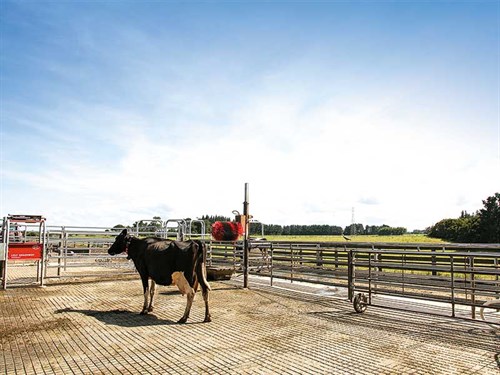
The grazing system is divided into A, B, and C blocks with the gate changing automatically to a new direction every eight hours or so.
Greg opens the gates to that day’s fresh paddock or break once the previous day’s paddock is cleared. The gates for that day are never shut so the cows can come and go freely. Cows come in for milking at their own pace, and they must come back to the cowshed to get diverted to the next paddock through a grazeway.
This lets cows that are ready for milking into the robot area, and the others are diverted to the fresh paddock, meaning that every cow has her turn through the 24 hours at getting to the fresh paddock early. Heifers and timid cows thrive in this system, as the pecking order is not so obvious.
Cows are rewarded with a small amount of mineralised pellets and a drop of molasses in the robot; the amount dependent on an individual cow’s production and fresh pasture post-milking.
The T4C (time for cows) management system

This gives Greg and Amy a real-time update on their herd and traceability of each animal. They only have to glance at their computer screen to see information on udder health, rumination, milk quality, milk production, heat detection, milking visits, time between milking, feed intake, and much more.
Amy focuses on the computer and data analysis, leaving Greg to do what he does best – farm. "We keep it simple," Amy says. "There’s so much information to take in, it could be brain draining. In the first year, there is a lot to learn and one challenge early on when things were very new was getting a phone call in the night."
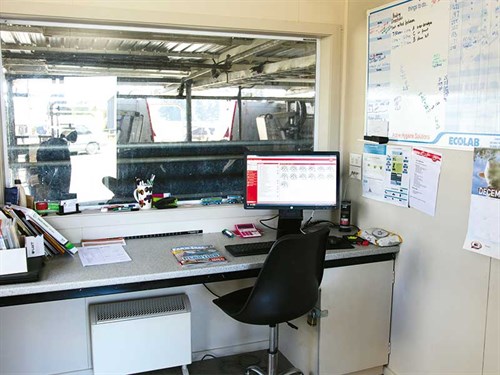
Greg says, "You have to be ahead of the robot; there’s detergents to fill, filters to change, and lasers to clean, and if you are not doing your housework, you’re going to have this ‘woman’ (the automated robot phone call) ringing you with a reminder.
Support from Lely
With so much to learn, especially in the beginning, support from the Lely Centre Manawatu and Bromley’s in Feilding has been vital, and they’ve delivered on their promise if a problem occurs.
"Lely says these machines have to be going within a certain time-frame and they stand by that. You are never left on your own to figure it out," Amy says.
Biological farming

The Schnell and Gemmell farm is run on biological soil principles and they no longer use urea. "Animal health begins with good soil," Greg says. Four years ago they were alerted to a problem, which, after testing, revealed a lack of iodine in their soil.
"We now use the Albrecht-Kinsey system through Kiwi Fertiliser. If you dug a hole on our farm, you’d find lots of worms and roots that go deep. There is so much lush clover too," Greg says.
Amy, Greg, and their family enjoy being part of their rural community. Greg belongs to the Colyton-Bunnythorpe Lion’s club and Amy started up and ran the local music and playgroup ‘Little Bunny’s’ for seven years. Thanks to the Lely Robots, the Gemmells are perfecting the work-play balance.
They also host numerous local and international tour groups, and Massey University agricultural and veterinarian students enjoy their placement on this farm of the future.
Pluses
- Individualised information on cows
- No more herd testing; the information is given at every milking
- Less stress on udder improves udder health
- Colostrum is automatically separated out to use for calves
- Lower vet bills
- Higher conception rates
- Easier to manage and improve pasture
- Possibility of less staff required but higher staff retention
- Eases some of the repetitive physical work for farmer
- Freedom from set milking times
- Contented, free-range cows
Minuses
- Numbers are capped per robot
- Cowshed is always in use. As soon as it is clean, there is another cowpat.
- Entrances and exits to cowsheds need to be in good condition and secure
Keep up to date in the industry by signing up to Farm Trader's free newsletter or liking us on Facebook


.jpg)
.jpeg)

.jpg)
.jpeg)
.jpg)
.jpeg)
.jpeg)



.jpg)



